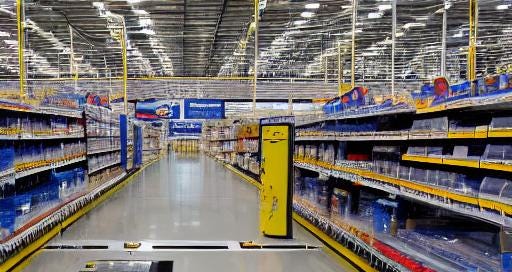Walmart Plans to Automate The Majority of Its Store Workforce by 2026
A Glimpse into the Future of Retail or a Cause for Concern For Unemployment & Income Inequality
Could robots become our new shopping companions? Walmart seems to think so with its plans to automate the majority of its store workforce by 2026.
Walmart's ambitious automation plan might offer a sneak peek into the future of retail.
But is this a step toward progress or a sign of looming unemployment and income inequality?
Let's dive in.
Walmart's Automation Plans
The well-known retail giant Walmart aims to have 65% of its stores running on automation by the end of its fiscal year 2026.
Considering the company's recent announcement to lay off over 2,000 workers at its online fulfillment facilities, we're left wondering how this push toward automation affects businesses, consumers, and the millions employed in the retail sector.
Insights and Takeaways
Businesses could look to Walmart as an example of harnessing technology to streamline operations and cut costs.
There's no doubt that Walmart's investment in automation will lead to greater efficiency across its supply chain, fulfillment centers, and online order processing. This is supported by the company's projection of a 20% improvement in unit cost averages by January 2026.
But what about the people working in retail?
Unfortunately, with the advancement of AI and automation, the future seems inevitable for the 9.8 million US employees directly tied to the retail sector.
While Walmart claims that automation will result in higher-paying roles and the creation of new jobs, many workers might need help convincing.
With an average age of 39, retraining and transitioning into new roles could be challenging for many employees.
Three Best-Case Scenarios
A Surge in Productivity and Economic Growth: Successfully implementing automation in retail could lead to substantial productivity gains and boost economic growth. Increased efficiency, quicker processing times, and better inventory management could lead to stronger businesses and an overall healthier economy.
New Job Opportunities: Automation might displace some workers, but it could also create new, higher-paying jobs in areas like robotics, AI, data analysis, and technology maintenance. This could lead to a positive shift in the labor market, with workers moving into more advanced, satisfying roles requiring different skill sets.
A Better Shopping Experience: Automation has the potential to greatly benefit consumers by enhancing the shopping experience. Faster, more efficient order processing, improved inventory management, and seamless integration of online and offline channels could result in more personalized and convenient shopping experiences, boosting customer satisfaction and loyalty.
Three Worst-Case Scenarios
Mass Unemployment: If other retailers follow in Walmart's footsteps and aggressively automate their operations, millions of retail workers could be jobless. The possibility of widespread unemployment and the following economic consequences cannot be ignored.
Growing Income Inequality: As lower-paying roles disappear and higher-paying positions are only available to those with the right skills, the income gap between skilled and unskilled workers could widen significantly. This would worsen existing income inequality and put even more strain on social welfare systems.
Loss of Human Experience: As businesses increasingly rely on automation, the valuable human touch in customer service could be lost. Automated systems, while efficient, may not be able to replicate the warmth, understanding, and empathy provided by human employees. This could lead to a sterile, impersonal shopping experience that leaves customers longing for the days when they could chat with a friendly cashier or receive personalized assistance from a helpful sales associate.
Preparing for the Future
Automation in retail seems unavoidable, but businesses, employees, and governments can take steps to soften the blow of any negative consequences.
The corporate takeover of AI and advancements in automation should include:
Investing in retraining programs for displaced workers.
Providing social safety nets.
Promoting a culture of lifelong learning to ensure a smooth transition for everyone involved.
Failing to do so could lead to a grim future for many workers and an unstable economy.
Opportunities or Challenges for the Future?
Walmart's automation goals offer opportunities and challenges for the retail industry. While the benefits of increased efficiency and cost savings are clear, it's crucial to consider the potential social and economic implications of widespread automation in the retail sector.
We can shape a future that balances technological advancements with the workforce's well-being by taking proactive steps to adapt.
Ultimately, it's up to businesses, governments, and individuals to come together and address the challenges posed by the rise of automation.
By fostering collaboration, providing support for affected workers, and promoting innovation, we can create a retail landscape that thrives in the face of change while ensuring the welfare of all stakeholders.
Quy Ma is a Category Management, Customer Insights, & Market Research Expert. With over 13 years of experience managing categories across different industries, he’s helped brands develop innovative new products & programs. He’s passionate about empowering businesses, connecting them with the right people, and maximizing the customer experience.






During the pandemic a lot of people employed in bars & restaurants landed at placed like Amazon & Walmart fulfillment centers. With these cuts looming, I wonder how many will/won't return.